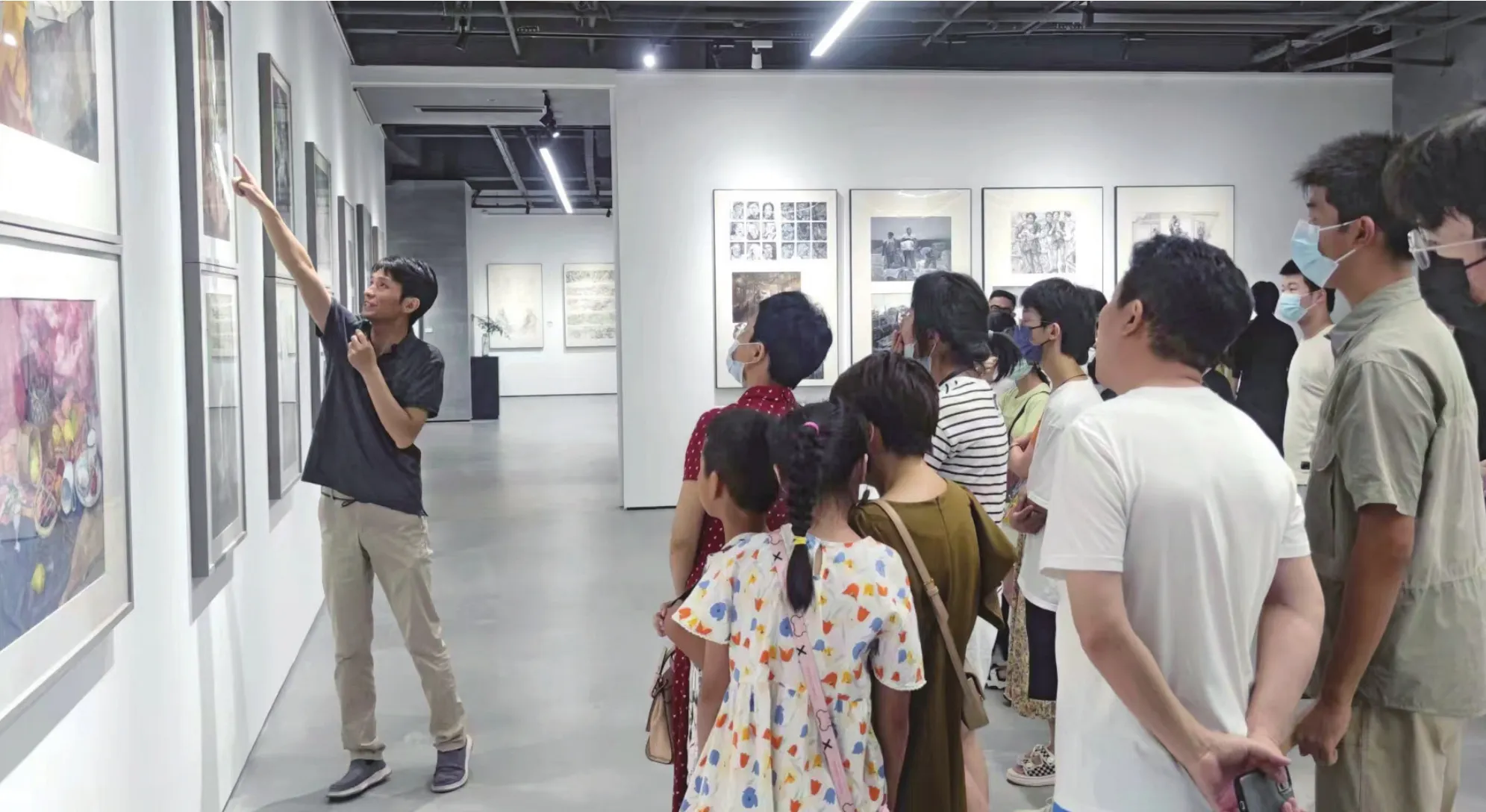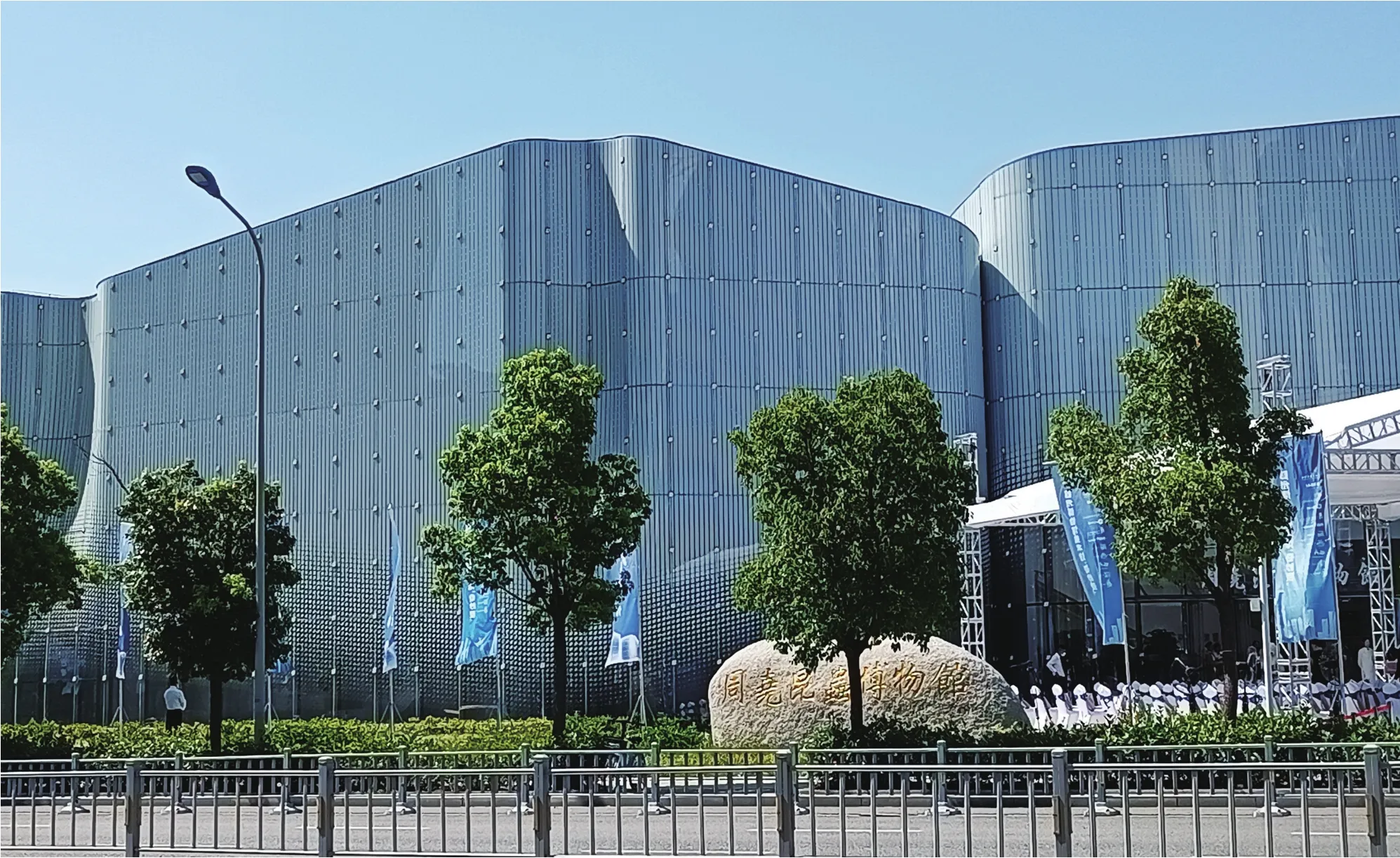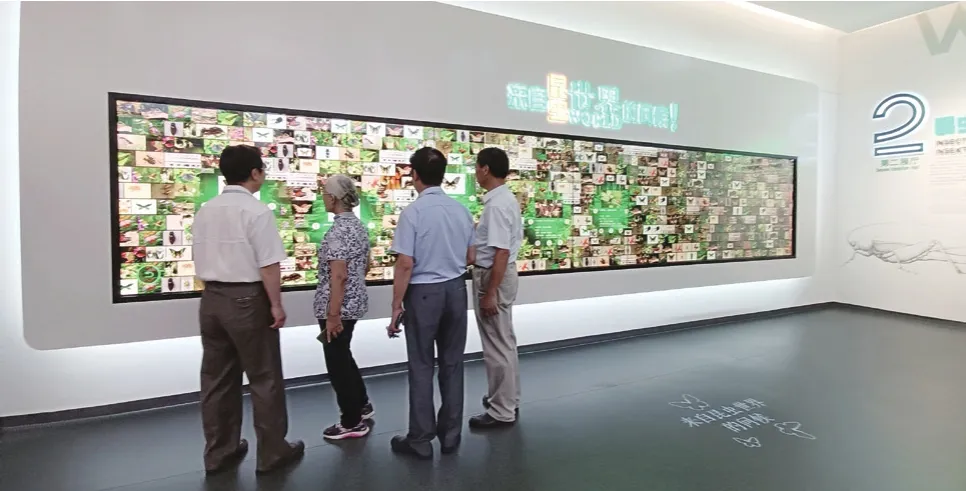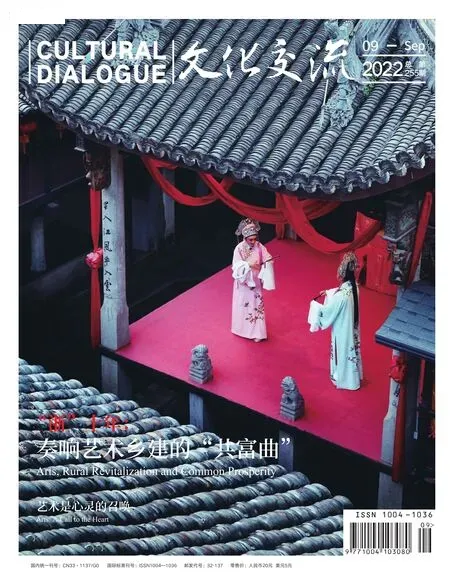逛博物馆,成为火出圈的时尚
文/吴海霞

宁波纳得美术馆夜游活动现场,由学术主持马善程博士导赏新展。Dr Ma Shancheng from Ningbo University works as a guide for a new exhibition during at a night event in Nart Museum, Ningbo city.
这个暑假哪里最火?不少宁波人会选择去试开放的周尧昆虫博物馆看切叶蚁,去宁波(鄞州)博物馆看恐龙。
在鄞州,这十年,各类博物馆拔地而起,逛博物馆不仅是一种生活方式,还是一种越来越火出圈的时尚。
爱上一座城,有很多理由,在博物馆看到历史与当下,也许就是其中一种。
“中国博物馆文化之乡”鄞州,目前已拥有博物馆、美术馆38座,平均每4万人一座,远超发达国家水平。博物馆群,正一遍遍刷新鄞州文化的高度与厚度。
爱上博物馆
哪里博物馆最多?
在宁波,这个答案一定是鄞州区下应街道湾底村。
中国插花艺术馆、宁波服装博物馆、鄞州非遗馆、旗袍文化会馆、千峰越窑青瓷博物馆、水墨艺术馆……
一个村的拥有,就是一个鄞州博物馆群的生动样本。
中国插花艺术馆—宁波唯一的国字号民营博物馆,也是鄞州首个有生命实物陈列的博物馆,带着露珠的鲜花绿叶成为大师手下的作品,让部分展陈内容常更常新,这里也是集培训、赛事、书画交流、古琴艺术等活动于一体的场所。
宁波服装博物馆,省级非遗项目红帮裁缝技艺的主题馆。
鄞州非遗馆,几经升级,已经成为游客参与体验、学生研学、国际友人了解中国文化的窗口。
此外,旗袍文化、青瓷文化、书画艺术……汇聚在不同场馆,带给参观者不同的体验与收获。
鄞州博物馆多姿多彩的形态,丰富多元的视角,开放包容的胸怀,都在一个村的样本里得以体现。
湾底村博物馆群是“中国博物馆文化之乡”的一个缩影。
鄞州的博物馆有多美、 有多酷,不去说馆藏,单是建筑外观就能惊艳时光。
中国首位普利兹克建筑奖获得者王澍设计的新乡土主义作品,在宁波一共有4个,其中3个在鄞州,并分别与3个文化场馆对应:宁波(鄞州)博物馆、华茂美术馆和鄞州公园“五散房”之一的李元摄影艺术馆。
简约而灵动的造型,旧石料与老砖瓦砌成的瓦爿墙,修竹、睡莲、水系,寄寓乡愁,也传达现代,这是宁波(鄞州)博物馆。
四面环水,有着江南民居清新典雅审美特色的,是宁波华茂美术馆。
参差的瓦爿墙,大跨度坡顶,青砖堆砌立面,在协调的色差之中,不同材质与造型的拼贴,交错出雅致清淡的美,这是李元摄影艺术馆。
爱上博物馆,其建筑本身就是最美的藏品。
酷炫的场馆远不止王澍的作品。
7月28日正式开馆的周尧昆虫博物馆,围绕“蝶”主题概念,造型和布局以此展开,兼具昆虫翅膀的轻薄质感,获得了2021年普罗奖最高荣誉“铂金奖”;华茂艺术教育博物馆,由享誉全球的葡萄牙国宝级建筑师阿尔瓦罗·西扎设计,这也是他当前设计的唯一“黑色系”作品,也是国内首家以艺术教育为主题的博物馆,已是宁波的“网红打卡地”,并获得“2020年度全球最佳建筑”等各类荣誉;堪称“不可移动文物”的庆安会馆,是国家级重点文物保护单位,会馆里蕴藏着各种民俗文化—妈祖文化、船文化、商帮文化,随处可见的精美石雕、木雕、砖雕,是一座令人目不暇接的雕刻艺术馆……
内涵与外观一样令人流连忘返。这么多座博物馆,各有各的主题,各有各的个性,各有各的气质。其中,非遗类的博物馆是较有辨识度的一种类型,除了上文提到的湾底村的插花、宁波服装、鄞州非遗等外,还有雪菜博物馆、甬式家具博物馆、金银彩绣艺术馆、朱金漆木雕博物馆、骨木镶嵌博物馆、甬剧博物馆等非遗类场馆。
同时,在鄞州的博物馆中,还有沙孟海书学馆、周尧昆虫博物馆、吴永良美术馆、毕春芳艺术馆、沙氏故居等规模、层次、定位各不相同,凸显名人文化品牌的博物馆、艺术馆;也有记录地域文化、历史变迁的滨海博物馆,以及散落在各社区、各村落居民和村民家门口的“迷你博物馆”。
走进博物馆,就是感受传统,链接现代;走进博物馆,也是在历史、文化、科技、自然等知识百科的“终身课堂”接受熏陶。在艺术审美中沉醉,在文脉传承中获得力量,在穿越时空的对话中遇见另一个自己。

宁波华茂美术馆。Huamao Art Museum in Ningbo.
好物拿出来
办博物馆,简单地说,就是把好物藏起来再拿出来的一个选择。
鄞州大地上,之所以有那么多博物馆、美术馆如雨后春笋般生长,是因为这里本身就有浩如烟海的“人间好物”,越来越多人愿意把它们拿出来、让社会共享,同时也有能撬动更多参与文化建设的公共热情的机制以引导和扶持。
去年底,省文物局公布了《浙江省文博事业发展水平评估指标数据(2020年度)》,在纳入评估的81个区(县、市)中,鄞州以94.82分位列全省第一名。
同时,看一组数据:鄞州拥有不可移动文物862处,包括古遗址、古墓葬、古建筑、石窟寺及石刻、近现代重要史迹及代表性建筑等,拥有世界文化遗产宁波三江口,海丝申遗点天童寺;国有馆藏文物藏品数93932件/套。
家底之丰厚,足见历史底蕴之厚重。“中国博物馆文化之乡”有着优秀的传统基因。
而更多的场馆,来自民营。激发了多少民间资本投入公共文化场馆的建设现在已经难以计数,但撬动民间藏家、民营企业家热情的,是政府的扶持和引导。
2008年,鄞州涌起民办博物馆热,积极鼓励扶持民办博物馆发展的模式开了全国先河,“中国博物馆文化之乡”就此起步。尤其是近十年,一座座民办博物馆更是如雨后春笋般涌现。
私人收藏向公众化转型,以及企业家投身公共文化事业提升品牌内涵,构成了鄞州民间资本热衷博物馆建设的大背景。
多年来,鄞州探索创新各种政策,鼓励民办博物馆发展,涉及资金补助、用地保障、人员配备、搭建各种推广传播平台等。
紫林坊艺术馆是鄞州首家民办博物馆,创办人是中国工艺美术大师、国家级非遗项目骨木镶嵌技艺传承人陈明伟。他告诉记者,办这个馆的初衷就是希望把宁波的工艺美术发扬光大,馆内有他的收藏和他创作的精品,将传统技艺之美,传递给公众。
华茂集团先后打造华茂美术馆、华茂艺术教育博物馆,其几十年积累的珍贵藏品是办馆的基础之一。元明清的文人字画精品,黄宾虹、徐悲鸿、刘海粟、潘天寿等国内现当代名家的作品,与提香 · 韦切利奥、菲力比诺 · 利皮等西方大师们的作品一起,展示了美术馆的实力、品格,从而成为本地艺术爱好者的精神殿堂。

宁波(鄞州)博物馆恐龙展。A dinosaur exhibition held at the Ningbo Museum.
其他如鱼文化博物馆、陶瓷博物馆、熨斗锡镴器博物馆等,都是民间藏家或者民营企业家,在政府倡导推动的良好氛围与风尚之下,积极以办馆的形式,把珍藏好物拿出来进行展示,并免费向公众开放,让它们真正“活起来”。
注入新活力
今年,“5 · 18国际博物馆日”的主题是“博物馆的力量”。
“博物馆有能力改变我们周围的世界。”
这样的能力是怎样生发,怎样强大起来的?
博物馆热的兴起,一方面有着中华优秀传统文化自身的魅力,以及增强民族文化自信的意识,另一方面也源于博物馆自身的破圈跨界,与更多社会资源链接,与年轻群体链接,与时尚潮流对话。
从央视的“国宝会说话”节目到故宫的网红文创,从苏州博物馆的一票难求到三星堆面具等引发的各种关于文物的话题……
突破时空界限,做好“博物馆+”新场域,盘活博物馆的有形和无形资源,成为让博物馆事业创新发展的重要引擎。
近十年来,鄞州作出了不少探索。
北京冬奥会期间,在中国工艺美术馆、中国非物质文化遗产馆举行的“中华瑰宝”—中国非物质文化遗产和工艺美术展上,紫林坊艺术馆馆馆长陈明伟的两件骨木镶嵌作品亮相。

宁波周尧昆虫博物馆。The Chow Io Entomological Museum in Ningbo.
多年来,陈明伟一手坚持工艺美术精品创作,黄杨木雕《人参如意》和骨木镶嵌《万工床》先后获得中国民间文艺“山花奖”,一手致力于博物馆文创品的推陈出新,先后开发了骨木镶嵌文房系列、家具系列等。2020年,他推出了骨木镶嵌箱包系列,将传统的元素与现代生活美学相融合,获得工艺美术界专家的赞誉。
另两家宁波传统工艺美术“三金一嵌”技艺主题博物馆—金银彩绣艺术馆和朱金漆木雕博物馆,也在服装、床上用品、工艺品、传统家具、佛像艺术等领域开拓了产业化传承。
灰雕艺术创作现代家装作品、渔船制作与餐具容器结合、钉碗技艺的瓷板画、越窑青瓷的虎形筷架……非遗馆里的文创产品,同样受到了人们的欢迎。
在鄞州,开发和展示文创品,已经成为很多博物馆的标配。
同时,博物馆的国际化交流,也让文物“流”起来、传起来。宁波(鄞州)博物馆与国内外众多博物馆合作举办过各类高规格临展,宁波服装博物馆也与湖北恩施等地开展过结对办展及交流。
在暑期,博物馆成为研学活动的热地。宁波华茂艺术教育博物馆梳理出国潮、版画、我与大师等八大系列美育课程;宁波纳得美术馆推出融入多种艺术及美学传播元素的特色主题夏令营,受到孩子们的欢迎。
在体验感较强的雪菜博物馆、鄞州非遗馆、甬式家具博物馆等文化场馆内,时常出现学生人头攒动的热烈场面。鄞州区文保中心主任金琪军说:“在文博场馆开展研学,通过专家介绍、课题研究、互动主题游戏、亲身体验等多种形式,可以零距离感受历史文化的魅力,跟祖先在精神层面进行沟通。”
宁波水墨艺术馆、汇港美术馆打通了收藏、拍卖、艺术品消费等线上线下交易体系;连续多年在鄞州举办的文创设计大赛,让来自全国各地的年轻设计师,将目光投向这些文博场馆,设计、开发出更多文创品,将鄞州的人文资源更好地传播并走向市场。
数字化场景建设是“博物馆+”未来发展的趋势。无论是增加数字文博“沉浸游”、云展览等线上体验空间,还是在线下场馆之中植入更多数字技术,如周尧昆虫博物馆声光电打造的虚拟体验区、互动区等,都是吸引流量、提升博物馆效应的途径。
有传承,有创新,在鄞州,一个全新的博物馆时代正在到来。那一扇扇向公众打开的线上线下的大门,将为鄞州文化建设注入新活力。
Visiting Museums: A Fashion for Ningbo Residents
By Wu Haixia
What are the most popular leisure activities this summer? A visit to the Chow Io Entomological Museum for a close-up view of leafcutter ants and a tour of the Ningbo Museum (also known as Yinzhou Museum) for its dinosaur exhibition must have been among the top choices. Over the past decade, Yinzhou district,Ningbo city has seen a growing number of museums. For the locals,visiting museums is not only a way of life, but a cool thing to do.
There are myriads of things that will make one fall in love with a city. Its museums where one can get a true sense of its past and present, for example, are probably such a thing. Yinzhou,known for its rich museum culture in China, is home to 38 museums and art galleries, which equals to one museum for every 40,000 residents, a figure much higher than those of its counterparts in many developed countries. Museum clusters are playing an important part in elevating the district’s cultural caliber.
Where can onefind the most museums in Ningbo? The answer is Yinzhou’s Wandi village whose long list of museums constitutes a great example of museum clusters there. The Chinese Floral Art Museum is the only private museum in Yinzhou prefixed with“Chinese” where blooming flowers and fresh leaves are transformed into intriguing exhibits in the hands of horticultural masters. The museum is also an ideal space for anything from training courses to competitions to art events on calligraphy, painting and(a plucked seven-string Chinese musical instrument of the zither family). Another member of the museum cluster is the Ningbo Garment Museum that showcases(literally “red gang”) tailoring techniques, an item on the list of the Intangible Cultural Heritage of Zhejiang province. The third example is the Yinzhou Intangible Cultural Heritage Museum. A window on Chinese culture, the upgraded museum offers engaging experiences for visitors and makes a fabulous destination for study tours.Furthermore, there are other captivating museums that specialize in various subjects including cheongsam, celadon, calligraphy and painting, all having a lot to offer culture-buffs. The museum cluster in Wandi village is the epitome of the museum culture of Yinzhou that values diversity and inclusion.

宁波李元摄影艺术馆展览开幕式上,学生们正在展厅观赏自己的作品与活动照片。During the opening of an exhibition at the Li Yuan Museum of Photographic Art, children of migrant workers look at their own works and photos.
When it comes to how arresting Yinzhou’s museums are, the museum architecture alone speaks volumes. Ningbo is home to four neo-vernacular buildings designed by Wang Shu, the first Chinese winner of the Pritzker Prize, and three of them are nestled in Yinzhou. Ningbo Museum features wapan masonry facades that are constructed with recycled bricks, tiles and other materials from demolished buildings, a traditional technique common in the area.Besides, the use of bamboo groves, water lilies, and water elements all contribute to a landscape reminiscent of the mountains surrounding the site. The nostalgic, simple yet agile architecture presents a contemporary translation of traditional construction practices. Surrounded by water on all sides, Huamao Art Museum in Ningbo is notable for its(south of the Yangtze River)folk house architectural style characterized by simplicity and elegance, commonly seen in regions along the Yangtze River’s lower reaches. As one of thefive experimental architecture projects in Yinzhou Park, Li Yuan Museum of Photographic Art reflects a distinctive Chinese aesthetic that favors natural materials and simplicity. With unevenwalls, long-span roofs and grey brick facades, the museum demonstrates a harmony of different colors, materials and shapes.
Visitors cannot help but fall in love with the museums in Yinzhou because the architecture there makes a most stunning collection, too. Apart from the designs by Wang Shu, Yinzhou’s museum ensemble includes other amazing ones. The Chow Io Entomological Museum was opened to the public on July 28, 2022.Its butterfly-inspired design has made it one of the five Platinum Pro winners of 2021 Pro+Award. Embodied in the architectural shape and arrangement, the design motif also captures the ultralightweight and delicate characteristics of an insect’s wings. Designed by Álvaro Siza Vieira, one of the most celebrated Portuguese architects, the Huamao Museum of Art Education is the only blackcolored construction in his design portfolio and has pocketed many awards including the Best Houses of 2020. Besides, it is China’sfirst museum dedicated to art education. Itsfine reputation, therefore,has turned it into a popular photo spot in Ningbo. The third one is Qing’an Guildhall, an example of immovable cultural relics. A treasure house of varying folklore traditions and dazzling sculptures of different types, the museum has been listed as a Major Historical and Cultural Site Protected at the National Level.
Indeed, what is inside Yinzhou museums is as fascinating as how they look from the outside. Among all the museums with varied themes and characteristics, museums focusing on specific intangible cultural heritage elements are the most distinctive. An impressive array of such elements include salted Chinese mustard greens,Ningbo furniture, Ningbo embroidery, Ningbo opera, gold lacquered wood carving, and bone inlay collections. The aforesaid Chinese Floral Art Museum, Ningbo Garment Museum, and Yinzhou Intangible Cultural Heritage Museum all fall into this category.
Further, Yinzhou has a variety of museums and galleries that are dedicated to prominent personages in different fields,showcases of the local culture and history, and aptly named “mini museums” because of their close-to-home location. Museums help us feel connected with traditions, throw light on the present, and nurture our mind with encyclopedic knowledge. They present enchanting artworks and valuable cultural legacies that empower us through dialogues across time and space.
Running a museum, put simply, is making a choice between locking real treasures away from the general public or putting them on display for visitors to marvel at. Why, then, are museums and galleries springing up all over Yinzhou? For one thing, the treasure-packed district boasts an increasing number of residents who are willing to make their priceless artifacts publicly available,and for another, Yinzhou has put in place supportive mechanisms to boost participation in promoting cultural development.
According to “Culture and Museums in Zhejiang: Evaluation Index and Stats of 2020” released by Zhejiang Provincial Cultural Heritage Administration, at the end of 2021, Yinzhou rankedfirst among 81 cities, counties and districts that were placed under assessment. Yinzhou is a depot for 862 immovable cultural relics such as ancient sites, ancient tombs and grotto temples, 2 world heritage sites and 93,932 pieces (sets) of cultural relics in state-owned museums. After a look at the above figures, one will immediately understand that the district, well endowed with cultural treasures,lives up to its reputation of being steeped in museum culture.
In fact, many museums in Yinzhou museums are owned by private entities who have invested massively in building local cultural facilities. The year 2008 saw a private museum boom in Yinzhou whose initiatives of supporting the development of private museums were a good example for other regions in the country. The number of private museums in the district has grown substantially in the last decade. The flourishing can be credited mainly to the local government whose support and guidance have not only steered individual collectors towards being willing to share their collections with the public but also inspired aspiring entrepreneurs to elevate their brands through investment in the cultural sector. For years,Yinzhou has been exploring a vast array of policies to facilitate the development of private museums, ranging from government funding to personnel allocation, provision of exhibition space and establishment of publicity platforms.
According to Chen Mingwei, founder of the Zilinfang Art Gallery, thefirst private museum in Yinzhou, the gallery that houses arts and crafts he has collected and created is meant primarily for the preservation, promotion, and education of local traditional craftsmanship. Huamao Group founded the Huamao Art Museum and the Huamao Museum of Art Education with the precious collections it has procured over decades. The gems of its collection include masterpieces of calligraphers and painters of the Yuan,Ming and Qing dynasties (1271-1911), paintings of famed modern Chinese artists, and works of influential western painters like Tiziano Vecellio (Titian) and Filippino Lippi. They are the telling proof of the strengths of the two museums, heaven for local art lovers.
Chen Mingwei and Huamao Group are just two examples among many individual collectors and private enterprises who have, thanks to the support from the local government,transformed private collections into private museums, and in so doing, they have brought ancient treasures to life.
The theme for the International Museum Day 2022, observed on May 18 every year, is “The Power of Museums”, namely,“museums have the power to transform the world around us”.How come museums have such power?
The burgeoning of museums in Yinzhou is, on the one hand,a matter of cultural confidence that originates from China’s broad and profound traditions and, on the other hand, an outgrowth of cross-sector collaboration that pools additional resources, engages young communities and follows trending topics. Cases in point include the program “Every Treasure Tells a Story” by China Central Television (CCTV), the internet-famous cultural products of the Palace Museum, the scramble for Suzhou Museum tickets, and the heated discussions on cultural relics triggered by the mysterious mask unearthed at Sanxingdui, an archaeological site outside Chengdu city.
Yinzhou museums have seen untiring efforts made in creatively utilizing their resources, online and offline, visible and invisible. For instance, Chen Mingwei has devoted years to developing bone inlay cultural products. The two product lines — bone inlay baggage and bone inlay furniture he launched in 2020 — won wide praise.During the 2022 Beijing Winter Olympics, two bone inlay artifacts he created were put on display at an exhibition held by China Intangible Cultural Heritage Museum and China National Arts and Crafts Museum. In addition, two local museums that focus on embroidery and gold-lacquered woodcarving respectively have both striven to inject new life into the traditional crafts by turning them into well-received cultural products like clothing, bedding and furniture. Creating and showcasing cultural products that are derived from transitional crafts and ancient relics has become a common practice of Yinzhou museums.
Additionally, the local museums have held international and domestic events to keep their ancient cultural artifacts alive.For example, Ningbo Museum has joined hands with museums inside and outside China in staging a wide variety of exhibitions.The Ningbo Garment Museum has collaborated with local organizations in Enshi city of Hubei province, for exhibitions and other exchange activities.
During the summer vacation this year, museums were among the top destinations for study tours. The Huamao Museum of Art Education offered eight art education programs. The most beloved summer camps of the Nart Museum provided participants with superb experiences that incorporated aesthetic elements into art activities. Moreover, students flocked to those museums featuring hands-on participatory learning. According to Jin Qijun, director of Yinzhou Cultural Relics Protection Center, students experience the charm of local history and culture through assorted activities like study tours, expert lectures, research projects and interactive games designed by these museums.
The Ningbo Ink Art Museum and the Ningbo HKE Art Museum have created trading systems that provide arts collectors and buyers with both online and offline access. Besides, Yinzhou has hosted for many years arts and design competitions that have drawn numerous young designers around the country to design and develop derivative cultural products by drawing on local museums, a practice intended for the marketing of cultural resources in Yinzhou.
Another emerging trend of local museums is to go digital either by providing online visitors with immersive experiences or harnessing virtual technologies to optimize on-site tours.Digitalization is playing a crucial role in attracting more visitors and boosting the value of museums. Yinzhou is ushering in a new era of museums where tradition and innovation are the dual engines of its cultural development.

宁波周尧昆虫博物馆展厅。An exhibition hall of the Chow Io Entomological Museum in Ningbo.

